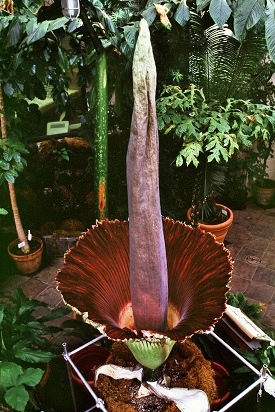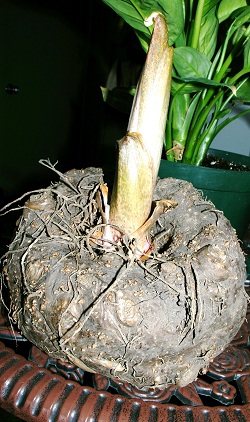Ever since I saw a slide of England’s Royal Botanical Garden at Kew’s Amorphophallus titanum, the biggest and smelliest flower on the planet in 1997, I wanted one.
Sir Geoffrey Lewis of Kew did a presentation at the Houston Art Museum about unusual plants to draw attention to the “Millennium Seed Bank” in which Kew was gathering, cataloging and preserving every know species of plant in the world. The 200-pound Titan tuber is on the Threatened Plant list and is in the collection to preserve it from rapidly disappearing rainforest environments.
I coveted one, despite its size. Covet grew to obsession in the last 15 years, because I found five relatives of the Titan. I can grow and flower Arum (amorphophallus) tubers easily here in USDA Climate Zone 5.
When Jeff Epping, director of horticulture at Olbrich Botanical Garden in Madison, WI, mentioned to me that he thought he could get me a bulb from the University of Wisconsin at Madison’s botany department, I screamed “Yes!!! … please.”

I picked up my ‘Titan’ Arum from Olbrich Botanical Garden last week and have been watching it grow by the inch daily!
I saw and photographed ‘Big Bucky’, as UW called their Titan, in June 2001 when it bloomed spectacularly. National television networks filmed the eight-foot-seven-inch flower unfurling. Too bad they didn’t have smellavision, because the odor was gut-wrenching, like rotting flesh with a dash of fetid cheese. Turns out that my Titan tuber was grown from a seed from ‘Big Bucky’! The UW tuber came from Sumatra, native home of Titan Arums.

This is Big Bucky, the Titan that bloomed at the University of Wisconsin in June 2001. It’s the daddy of my Titan.
Arums are related to calla lilies, anthurium, philodendron and dieffenbachia. Many of them have blooms, too, but they don’t stink. A few of the larger Arums emit smells of ripe bananas and even vanilla. I have several ‘Konjac’ Arums that smell almost as bad as the Titan, but their flowers are only five-feet-tall at the most and quite narrow, about 18 inches in diameter.

Many Arum tubers grow to be huge. This ‘Konjac’ from my collection is 31 pounds. ‘Titan’ tubers can hit 200 pounds!
Mechanics of the rotting corpse smell
Many refer to Titans as corpse flowers, because of their odor, which is composed of heavy, sulfur-based compounds that do not become airborne easily. The plant heats itself up in order to volatilize its “perfume,” enabling the smell to go further, attract more flies, and increase the chance of pollination. To heat up, the plant “burns” stored carbohydrates, short-circuiting its basic respiratory process in order to maximize the production of heat.
Many members of the Arum family perform metabolic burns like this, but on a smaller scale. Unfortunately, the enormous amount of energy the plant expends in attracting flies limits the amount of time it can bloom. That’s why these plants typically bloom for only a few days, and why they don’t bloom every year.
During bloom, the tip of the spadix (the central spike) is about human body temperature. The rest of the spadix is cooler (though still warmer than the surrounding air), but the surrounding spathe is cool.
My tuber is about ten years old, I’ve been told, and it should bloom next summer or the summer after. I’m SO excited. And, you faithful readers will get the first pictures and details when it flowers in all its stinky glory!
Update: See my post on my “Stinky Corpse Flowers Putting on a Good Show Indoors!”













